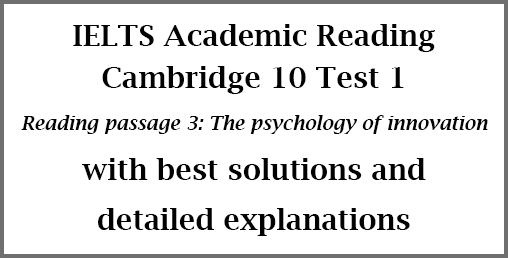IELTS Academic Reading: Cambridge 10 Test 1, Reading passage 3: The psychology of innovation; with best solutions and explanations
This IELTS Reading post deals with a total solution package for IELTS Cambridge 10 Reading Test 1 Passage 3 entitled The psychology of innovation. This is a targeted post for candidates who have big difficulties in finding Reading Answers. This kind of post can direct you the best to understand every Reading answer easily. Finding IELTS Reading answers is a gradual process and I hope this post can help you in this respect. You need to practice the answers using the Cambridge 10 book.

Reading Passage 3:
The headline of the passage: The psychology of innovation
Questions 27-30 (Multiple Choice Questions)
[Multiple choice questions is a common type of question set in IELTS Reading test. It is also found in Listening test. Most of the time, they come with four options but sometimes there are three options. Candidates need to work hard for this type of questions because this may confuse them easily in passage 2 or passage 3. There will be long answers for each question, so they may kill valuable time. So, quick reading or skimming technique might come handy here. Remember that answers in 3 options out of 4 will be very close. So, vocabulary power will help a lot to choose the best answer.]
[TIPS: Skimming is the best reading technique here. You need not understand every word here. Just try to gather the gist of the sentences. That’s all. Read quickly and don’t stop until you finish each sentence.]
Question 27: The example of the ‘million-dollar quartet’ underlines the writer’s point about –
Keywords for this question: ‘million-dollar quartet’
The phrase ‘million-dollar quartet’ is found in paragraph no. 3, line 7. A quick skimming of the paragraph lets us know that ‘million-dollar quartet’ was, in fact, a famous picture of four great “….. … singers Elvis Presley, Carl Perkins, Jonny Cash and Jerry Lee Lewis jamming at a piano in Sun Studios in Memphis …. .. .” However, the paragraph also points out that the picture missed another great singer of the time who was Roy Orbison. The four singers joined hands together at Sun Studios under Sam Phillips, but ‘… .. . Orbison wasn’t inspired by the goal, and only ever achieved one hit with the Sun label’.
This means Orbison did not like the idea of sharing success.
So, the answer is: C (having a shared objective)
Question 28: James Watson suggests that he and Francis Crick won the race to discover the DNA code because they –
Keywords for this question: James Watson, Francis Crick, won, discover the DNA code,
In paragraph no. 6 we find the mention of James Watson and Francis Crick, the great minds who discovered DNA code. Here, in this paragraph, look at lines 18-20. “….. he (James Watson) and Crick had succeeded because they were aware that they weren’t the most intelligent of the scientists pursuing the answer.”
It means both James Watson and Francis Crick knew that they had learning limitations.
So, the answer is: A (were conscious of their own limitations)
Question 29: The writer mentions competitions on breakfast cereal packets as an example of how to –
Keywords for this question: competitions on breakfast cereal packets
In paragraph no. 8, ‘competitions on breakfast cereal packets’ is mentioned in lines 8-9. The reason of mentioning this example is described just before. In lines 5-7, the writer says, “….. . . even something as simple as writing deepens every individual’s engagement in the project.”
So, the answer is: D (strengthen commitment to an idea)
Question 30: In the last paragraph, the writer suggests that it is important for employees to –
Keywords for this question: important for employees to
In the middle of the last paragraph, lines 4-9, we find the final comments of Cialdini. “ … … Cialdini says: ‘Leaders should encourage everyone to contribute and simultaneously assure all concerned that every recommendation is important to making the right decision and will be given full attention.’ … ..”
This means that company owners or employers should provide a view to their employees that they (employees) are also a big part of the company and their suggestions are valued.
So, the answer is: B (feel that their contributions are valued)
Questions 31-35 (Completing sentences with correct endings)
[For this type of question, candidates need to match the beginning and ending of sentences. Candidates need to look for keywords in the sentence-beginnings and find the relative paragraphs and then sentences in the passage. Skimming and scanning, both reading skills are essential for this question-type.]
Question 31: Employees whose values match those of their employers are more likely to –
Keywords for this question: values, match, more likely to,
In paragraph no. 2, the writer says in lines 5-12, “. . . .. . Research shows that the fit between an employee’s values and a company’s values makes difference to what contribution they make and whether they’re still at the company”.
This clearly suggests that the matching or fitting of value has an influence on whether employees stay in their present jobs or not.
So, the answer is: G (remain in their jobs)
Question 32: At times of change, people tend to –
Keywords for this question: time of change,
In paragraph no. 4, the writer mentions in lines 4-6, “ . .. .. when things change, we are hard-wired to play it safe.”
This line suggests that when there are changes we or people try our best to play safe or avoid risks.
So, the answer is: E (avoid risk)
Question 33: If people are aware of what they might lose, they will often –
Keywords for this question: if, aware, might lose, will often
At the end of paragraph no. 4 the writer says, “.. .. . studies show that we invariably take more gambles when threatened with a loss than when offered a reward”.
This means that when people are threatened with a loss or damage, people will take gambles or chances.
So, the answer is: A (take chances)
Question 34: People working under a dominant boss are liable to –
Keywords for this answer: dominant boss, liable to,
In paragraph no. 9, lines 7-11, we find comments of Cialdini, “. .. . crew members of multipilot aircraft exhibit a sometimes deadly passivity when the flight captain makes a clearly wrong-headed decision. This behaviour is not unique to air travel, but can happen in any workplace where the leader is overbearing.”
These lines indicate the fact that people working under an overbearing or dominant boss tend to take more passive decision or action.
To be more precise, they become liable to ignore their duties.
So, the answer is: F (ignore their duties)
Question 35: Employees working in organisations with few rules are more likely to –
Keywords for this answer: employees, with few rules
We find the answer in paragraph no. 10 Here, the writer specifies that the environment ‘. .. . where the only rule was that there were no rules.. ..’ … … .. . ‘.. . .encouraged a free interchange of ideas…. ..’
*interchange = share
This means that employees who work in organisations with few rules are more likely to interchange or share their ideas.
So, the answer is: B (share their ideas)
Questions 36-40 (YES/NO/NOT GIVEN):
[In this type of question, candidates are asked to find out whether:
The statement in the question matches with the account in the text- YES
The statement in the question contradicts the account in the text- NO
The statement in the question has no clear connection with the account in the text- NOT GIVEN
For this type of question, you can divide each statement into three independent pieces and make your way through with the answer.]
Question 36: The physical surroundings in which a person works play a key role in determining their creativity.
Keywords for this answer: surroundings, determining creativity
In paragraph no. 1, lines 3-9 say, “There are, nevertheless, people working in luxurious, state-of-the-art centres designed to stimulate innovation who find that their environment doesn’t make them feel at all creative. And there are those who don’t have a budget, or much space, but who innovate successfully.”
This means that the working environment or physical surroundings of the workplace does not affect the employees’ creativity.
So, the answer is: NO
Question 37: Most people have the potential to be creative.
Keywords for this answer: potential, creative,
In paragraph no. 2, lines 11-14, the writer says, “… . .. . although some individuals may be more creative than others, almost every individual can be creative in the right circumstances.” The lines clearly agree with the statement.
So, the answer is: YES
Question 38: Teams work best when their members are of equally matched intelligence.
Keywords for this answer: work best, equally matched intelligence
We find a reference to teamwork in paragraph no. 7. However, there is no mention of whether teamwork gives the best work result when team members are equally intelligent.
So, the answer is: NOT GIVEN
Question 39: It is easier for smaller companies to be innovative.
Keywords for this answer: easier, smaller companies, innovative
Again, in paragraph 5, the author only argues in lines 2-6, “It’s easy for a company to be pulled in conflicting directions as the marketing, product development, and finance departments each get different feedback from different sets of people.” The author also says in lines 8-10, “… .. .it’s also easy for small ‘pockets of innovation’ to disappear.”
Therefore, ‘whether it is easy or difficult for smaller companies to be creative or innovative’ is not clearly mentioned here.
So, the answer is: NOT GIVEN
Question 40: A manager’s approval of an idea is more persuasive than that of a colleague.
Keywords for this answer: manager’s approval, more persuasive
At the last part of paragraph no. 7, the writer mentions in lines 8-11, “.. . . Research shows that peer power, used horizontally not vertically, is much more powerful than any boss’s speech.”
So, the statement clearly contradicts with the view of the writer. It means a colleague or peer’s speech is more persuasive or powerful than a boss.
So, the answer is: NO
Click here for solutions to Cambridge 10 Test 1 Reading Passage 1
Click here for solutions to Cambridge 10 Test 1 Reading Passage 2




It help me a lot because in solutions you gave me reasons for right answers that’s why.
It’s so useful. I can see my improvement with the help of your detail explanation
I am happy to help!
What is the meaning of “ used horizontally not vertically” in Cambridge 10 test 1 passage 3 7th paragraph
I really appreciate for your gorgeous method for analyzing the passages.
You’re most welcome!